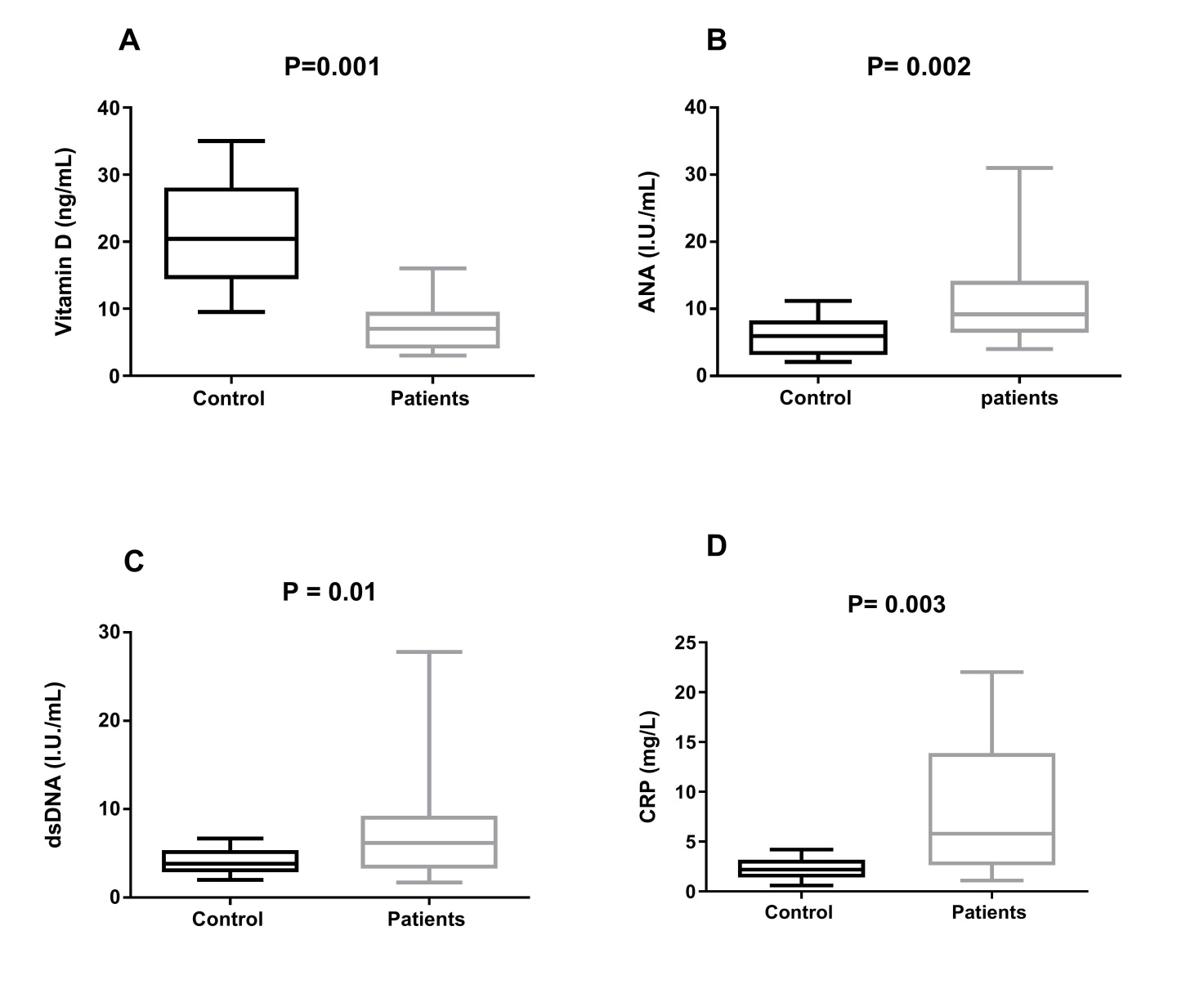Role of vitamin D and some immunological markers in polycystic ovarian syndrome.
DOI:
https://doi.org/10.21271/ZJPAS.35.5.9Keywords:
Autoimmune markers, C. reactive protein, Polycystic ovary syndrome, Vitamin DAbstract
Polycystic ovarian syndrome (PCOS) is the most widespread endocrine-metabolic disorder in women of reproductive age, which is a very common disorder. The current study aimed to determine the levels of vitamin D and immunological markers like antinuclear antibodies (ANA), anti-double strand DNA (dsDNA) and C. reactive protein (CRP) in the serum of PCOS-affected women. Blood samples were collected from forty polycystic women depending on the Rotterdam criteria. Forty fertile women of similar ages made up the control group. The Blood samples were analyzed to measure the levels of an endocrine hormone and vitamin D by Cobas e411; ANA and ds DNA determined by Enzyme-Linked Immunosorbent Assay ( ELISA), And CRP measured by Cobas C111. This study revealed a significant decrease in vitamin D in PCOS patients contrasted to the control group, while CRP, ANA, and dsDNA increased significantly in PCOS patients. Finding low vitamin D and high ANA, ds DNA in PCOS women may have a role in the aetiology of PCOS. Screening for autoantibodies and vitamin D in women with PCOS may provide better insight into its role in PCOS.
References
ABRAHAM GNANADASS, S., DIVAKAR PRABHU, Y. & VALSALA GOPALAKRISHNAN, A. 2021. Association of metabolic and inflammatory markers with polycystic ovarian syndrome (PCOS): an update. 303, 631-643.
BOGARI, N. M. 2020. Genetic construction between polycystic ovarian syndrome and type 2 diabetes. Saudi J Biol Sci, 27, 2539-2543.
BOULMAN, N., LEVY, Y., LEIBA, R., SHACHAR, S., LINN, R., ZINDER, O. & BLUMENFELD, Z. 2004. Increased C-reactive protein levels in the polycystic ovary syndrome: a marker of cardiovascular disease. J Clin Endocrinol Metab, 89, 2160-5.
BRUNI, V. & CAPOZZI, A. 2022. The Role of Genetics, Epigenetics and Lifestyle in Polycystic Ovary Syndrome Development: the State of the Art. 29, 668-679.
BURT SOLORZANO, C. M., BELLER, J. P., ABSHIRE, M. Y., COLLINS, J. S., MCCARTNEY, C. R. & MARSHALL, J. C. 2012. Neuroendocrine dysfunction in polycystic ovary syndrome. Steroids, 77, 332-7.
BUSIAH, K., COLMENARES, A., BIDET, M., TUBIANA-RUFI, N., LEVY-MARCHAL, C., DELCROIX, C., JACQUIN, P., MARTIN, D., BENADJAOUD, L., JACQZ-AIGRAIN, E., LABORDE, K., ROBERT, J. J., SAMARA-BOUSTANI, D. & POLAK, M. 2017. High Prevalence of Polycystic Ovary Syndrome in Type 1 Diabetes Mellitus Adolescents: Is There a Difference Depending on the NIH and Rotterdam Criteria? Horm Res Paediatr, 87, 333-341.
EAGLESON, C. A., GINGRICH, M. B., PASTOR, C. L., ARORA, T. K., BURT, C. M., EVANS, W. S. & MARSHALL, J. C. 2000. Polycystic ovarian syndrome: evidence that flutamide restores sensitivity of the gonadotropin-releasing hormone pulse generator to inhibition by estradiol and progesterone. J Clin Endocrinol Metab, 85, 4047-52.
EZZAT, R. S., ABDALLAH, W., ELSAYED, M., SALEH, H. S. & ABDALLA, W. 2021. Impact of bariatric surgery on androgen profile and ovarian volume in obese polycystic ovary syndrome patients with infertility. Saudi J Biol Sci, 28, 5048-5052.
GANIE, M. A., MARWAHA, R. K., AGGARWAL, R. & SINGH, S. 2010. High prevalence of polycystic ovary syndrome characteristics in girls with euthyroid chronic lymphocytic thyroiditis: a case-control study. Eur J Endocrinol, 162, 1117-22.
GAO, L., GU, Y. & YIN, X. 2016. High Serum Tumor Necrosis Factor-Alpha Levels in Women with Polycystic Ovary Syndrome: A Meta-Analysis. PLoS One, 11, e0164021.
HE, C., LIN, Z., ROBB, S. W. & EZEAMAMA, A. E. 2015. Serum Vitamin D Levels and Polycystic Ovary syndrome: A Systematic Review and Meta-Analysis. Nutrients, 7, 4555-77.
HEFLER-FRISCHMUTH, K., WALCH, K., HUEBL, W., BAUMUEHLNER, K., TEMPFER, C. & HEFLER, L. 2010. Serologic markers of autoimmunity in women with polycystic ovary syndrome. Fertil Steril, 93, 2291-4.
HU, W., QIAO, J., YANG, Y., WANG, L. & LI, R. 2011. Elevated C-reactive protein and monocyte chemoattractant protein-1 in patients with polycystic ovary syndrome. Eur J Obstet Gynecol Reprod Biol, 157, 53-6.
JOHANSSON, J. & STENER-VICTORIN, E. 2013. Polycystic ovary syndrome: effect and mechanisms of acupuncture for ovulation induction. Evid Based Complement Alternat Med, 2013, 762615.
KARIM, D. H., MOHAMMED, S. M. & AZEEZ, H. A. 2021. Impact of vitamin D3 Nanoemulsion on spermatogenesis and antioxidant enzymes in Vitamin D deficient induced albino male rats. Zanco Journal of Pure and Applied Sciences, 33 (1): 55-67.
KIM, J. J., CHOI, Y. M., CHAE, S. J., HWANG, K. R., YOON, S. H., KIM, M. J., KIM, S. M., KU, S. Y., KIM, S. H. & KIM, J. G. 2014. Vitamin D deficiency in women with polycystic ovary syndrome. Clin Exp Reprod Med, 41, 80-5.
KOWALCZYK, K., FRANIK, G., KOWALCZYK, D., PLUTA, D., BLUKACZ, Ł. & MADEJ, P. 2017. Thyroid disorders in polycystic ovary syndrome. Eur Rev Med Pharmacol Sci, 21, 346-360.
LIN, L. H., BARACAT, M. C., MACIEL, G. A., SOARES, J. M., JR. & BARACAT, E. C. 2013. Androgen receptor gene polymorphism and polycystic ovary syndrome. Int J Gynaecol Obstet, 120, 115-8.
MACUT, D., BJEKIĆ-MACUT, J., RAHELIĆ, D. & DOKNIĆ, M. 2017. Insulin and the polycystic ovary syndrome. Diabetes Res Clin Pract, 130, 163-170.
MATTILA, C., KNEKT, P., MäNNISTö, S., RISSANEN, H., LAAKSONEN, M. A., MONTONEN, J. & REUNANEN, A. 2007. Serum 25-hydroxyvitamin D concentration and subsequent risk of type 2 diabetes. Diabetes Care, 30, 2569-70.
MENICHINI, D., FORTE, G., ORRU, B., GULLO, G., UNFER, V. & FACCHINETTI, F. 2022. The role of vitamin D in metabolic and reproductive disturbances of polycystic ovary syndrome: A narrative mini-review. Int J Vitam Nutr Res, 92, 126-133.
MU, Y., CHENG, D., YIN, T. L. & YANG, J. 2021. Vitamin D and Polycystic Ovary Syndrome: a Narrative Review. 28, 2110-2117.
NDEFO, U. A., EATON, A. & GREEN, M. R. 2013. Polycystic ovary syndrome: a review of treatment options with a focus on pharmacological approaches. P t, 38, 336-55.
NISAR, S., SHAH, P. A., KUCHAY, M. S., BHAT, M. A., RASHID, A., AHMED, S. & GANIE, M. A. 2012. Association of polycystic ovary syndrome and Graves' disease: Is autoimmunity the link between the two diseases. Indian J Endocrinol Metab, 16, 982-6.
PATEL, K., COFFLER, M. S., DAHAN, M. H., MALCOM, P. J., DEUTSCH, R. & CHANG, R. J. 2004. Relationship of GnRH-stimulated LH release to episodic LH secretion and baseline endocrine-metabolic measures in women with polycystic ovary syndrome. Clin Endocrinol (Oxf), 60, 67-74.
PITTAS, A. G., DAWSON-HUGHES, B., LI, T., VAN DAM, R. M., WILLETT, W. C., MANSON, J. E. & HU, F. B. 2006. Vitamin D and calcium intake in relation to type 2 diabetes in women. Diabetes Care, 29, 650-6.
REIMAND, K., TALJA, I., METSKULA, K., KADASTIK, U., MATT, K. & UIBO, R. 2001. Autoantibody studies of female patients with reproductive failure. J Reprod Immunol, 51, 167-76.
RICHARD, S. & RICARDO, A. 2003. Androgen excess disorders. Danforth’s Obstetrics and Gynecology. Lippincott Williams & Wilkins, Philadelphia.
ROMITTI, M., FABRIS, V. C., ZIEGELMANN, P. K., MAIA, A. L. & SPRITZER, P. M. 2018. Association between PCOS and autoimmune thyroid disease: a systematic review and meta-analysis. Endocr Connect, 7, 1158-1167.
SáNCHEZ-FERRER, M. L., PRIETO-SáNCHEZ, M. T., CORBALáN-BIYANG, S., MENDIOLA, J., ADOAMNEI, E., HERNáNDEZ-PEñALVER, A. I., CARMONA-BARNOSI, A., SALIDO-FIERREZ, E. J. & TORRES-CANTERO, A. M. 2019. Are there differences in basal thrombophilias and C-reactive protein between women with or without PCOS? Reprod Biomed Online, 38, 1018-1026.
SIR-PETERMANN, T., CODNER, E., PEREZ, V., ECHIBURú, B., MALIQUEO, M., LADRóN DE GUEVARA, A., PREISLER, J., CRISOSTO, N., SáNCHEZ, F., CASSORLA, F. & BHASIN, S. 2009. Metabolic and reproductive features before and during puberty in daughters of women with polycystic ovary syndrome. J Clin Endocrinol Metab, 94, 1923-30.
SPROSTON, N. R. & ASHWORTH, J. J. 2018. Role of C-Reactive Protein at Sites of Inflammation and Infection. Front Immunol, 9, 754.
THOMSON, R. L., SPEDDING, S. & BUCKLEY, J. D. 2012. Vitamin D in the aetiology and management of polycystic ovary syndrome. Clin Endocrinol (Oxf), 77, 343-50.
TOSI, F., NEGRI, C., PERRONE, F., DORIZZI, R., CASTELLO, R., BONORA, E. & MOGHETTI, P. 2012. Hyperinsulinemia amplifies GnRH agonist stimulated ovarian steroid secretion in women with polycystic ovary syndrome. J Clin Endocrinol Metab, 97, 1712-9.

Downloads
Published
How to Cite
Issue
Section
License
Copyright (c) 2023 Ashraf Najeeb Kakoo , Fikry Ali Qadir

This work is licensed under a Creative Commons Attribution 4.0 International License.













